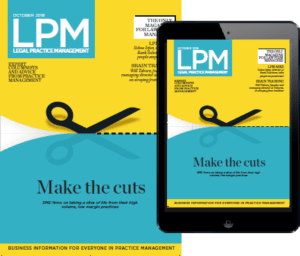
How can firms adapt their short-term finances to a post-pandemic normal?
Things are starting to look up for the legal sector, says Mike Stevenson at Iceberg, but changes in the landscape may mean firms need to reconsider their short-term finances.
Things are starting to look up for the legal industry. Smith and Williamson’s latest Law Firm Survey has revealed a great deal of optimism across the sector, as 69% of law firms surveyed feel reasonably confident about the business outlook of their firm.
It would seem the legal sector is starting to bounce back – but what has fuelled this recovery and what can SME law firm leadership do to maintain their trajectory?
When the pandemic struck, the Government rapidly rolled out a range of support initiatives to help businesses keep their heads above water. Smith and Williamson’s survey showed that the furlough scheme was widely adopted by the sector, with 70% of law firms furloughing staff, while the deferral of VAT payments was taken up by 30% of businesses.
The Coronavirus Business Interruption Loan Scheme (CBILS) was used by around one in ten law firms, offering businesses long-term cash reserves that they can use as a buffer as they work towards post-pandemic recovery.
SMEs were prepared for a crisis
There is certainly evidence that the financial crash of 2008 offered lessons for many industries, including the legal sector, as to how to deal with an economic crisis.
When the pandemic struck, building cash reserves became a key priority. The legal industry sprang into action – looking both outside and in for solutions to help navigate loss of revenue. As well as taking up Government schemes and exploring financing options with their banks, we saw SMEs within the sector make changes to improve billing processes and reduce drawings for partners.
This is certainly an ongoing journey for firms, which will require a continuous search for ways to make efficiency gains and reduce overheads, especially as firms navigate the next few months. There are numerous ways this can be done, one of which is moving to a permanent flexible-working office model that facilitates reduced office space costs. Another is to implement processes and incentives that reduce staff turnover.
Short-term financing options
As we emerge from the pandemic, legal businesses will need to adopt a flexible approach to managing cash flow issues. Maintaining high levels of liquidity will be helpful in ensuring SMEs are equipped for what could be an uncertain few months. As part of this, legal businesses might want to consider where shorter-term financing options fit into their plans – including around Professional Indemnity Insurance and tax payments.
The former might pose a challenge because the pandemic has rendered the insurance market particularly challenging. A recent report by broker Lockton outlined that premiums are at an all-time high as insurers prepare themselves for a barrage of claims. Tax payments, including VAT and partners’ tax, will need to be managed carefully now that deferring payments is no longer an option. Balancing short- and long-term financing needs will be key to creating a smooth, post-pandemic recovery.

Finding the key to lockup for a smooth post-pandemic recovery
If your lockup rate exceeds the industry average of between 10% and 20% of total billings and constitutes mostly of overdue invoices, it might be time to review your processes and make some changes, warns Mike Stevenson, managing director at Iceberg.
Is resolving the industry-old challenge of lockup the secret to a smooth post-Covid-19 business recovery?
As we emerge from the pandemic, making billing processes as efficient as possible will be key in ensuring a smooth transition back to ‘normality’. While a steady pipeline of client work may take some time to build back up again, it’s crucial for law firms to ensure they’re getting paid on time for the work they do.
Of course, some level of lockup is inevitable as there’s a guaranteed delay between completing the work and receiving payment for an invoice. However, if your lockup rate exceeds the industry average of between 10% and 20% of total billings and constitutes mostly of overdue invoices, it might be time to review your processes and make some changes.
Because of Solicitors Regulation Authority (SRA) regulations, financing options around book debt are limited. Firms must adopt a ‘back to basics’ approach, working closely with clients and fee earners in order to improve payment processes.
- Review the process currently in place
The first step is asking the fundamental question: who is responsible for ensuring that invoices are paid on time? Within SME law firms especially, that duty often comes down to the lawyers themselves. However, this will feel like a conflict of interest for many fee earners – their priority is to preserve a great relationship with their clients and chasing invoices multiple times can feel counter-intuitive.
If fee earners are consistently failing to meet their payment targets, it might be time to consider whether the role of chasing invoices should sit elsewhere. An option would be for this to be passed onto an external party that has no relationship with the client, either within the firm or outsourced.
- Commit to training
If taking the responsibility away from fee earners isn’t an option, then the solution might be in investing in some training to help them develop better oversight of the entire payment policy process.
As part of this, it’s important for finance team to really understand the concerns of fee earners and offer proactive support and solutions. The training should be tailored to the individual processes and challenges of a firm.
It should include general financial and cashflow insight, so that lawyers can understand why it’s so important for invoices to be paid on time and the impact of sustained delays. It will also be helpful to establish some detailed and clearly set out processes, so lawyers know exactly when, and how, to chase their clients.
- Outline clear communications around payment policy
In order to educate fee earners on a firm’s payment policy, it’s important to ensure that the policy itself is detailed and clearly explained.
It’s worth reviewing the comms around payment policy to see if those can be improved. Communications should be detailed with clear timing scales and payment options. They should also include a cohesive guide around debt recovery policies and procedures.
It’s also worth considering how payment policy information is communicated to clients – is this proactively shared with them and explained? Are there clear lines of communication with clients, with efforts taken to ensure they understand all options available to them? If the answer to that question is no, you might want to review if the firm needs clearer client communication processes.
- Offer flexible options to clients
The pandemic has been an incredibly difficult time for a lot of businesses, and this will include many of your clients. As much as we all want invoices paid, it’s important to take this into account when following up with clients.
Do you have flexible payment terms and payments plans as options available to help clients that might be struggling? If not, now might be a good time to introduce them. Taking the time to show care and compassion during the bad times will make all the difference later down the line.

Competitive edge: Law of attraction
Most Popular

Where are the challenges for SME law firm leadership changing?

The leading annual picture of SME law firms' changing strategic priorities

Law firms undertaking identity verification checks must register as an ASCP

Robust onboarding processes are fundamental to effective risk prevention
TA Triumph-Adler provides tailored support to meet compliance requirements

Osprey Approach's webinar explores the benefits of a digital-first approach

What are the biggest risks to SME law firms emerging from the pandemic?
Mike Stevenson at Iceberg says SME law firms must carefully manage their financial liquidity situation and balance this against talent retention needs as government-backed Covid-19 business support winds down
We are now well into the second quarter of the year, which has so far proved just as unpredictable as the last. Many law firms will still be sticking to the approach they’ve applied throughout 2020 – doing their best to predict which financial challenges might be on the horizon and then planning for the worst-case scenario.
However, as we look to the second half of the year, some risks stand out as more significant than others. There are also some considerations to make and measures to take in order to ensure the rest of 2021 (and beyond) is as smooth sailing as it can be.
Making the most of the support available
Now the Coronavirus Business Interruption Loan Scheme (CBILS) has come to an end, firms that have successfully applied for the funds need to also consider the best way to use them.
If legal businesses have successfully applied for one or more CBIL, they might want to use those funds as a buffer to create long-term, stable liquidity. Firms can consider more short-term financing options for expenses due in less than 12 months, which are tailored to this purpose.
Managing the end of the furlough scheme
The Law Society’s financial benchmarking survey recently revealed that a third of law firms are planning to make redundancies once the furlough scheme ends.
The scheme has proved an invaluable lifeline for many businesses and dealing with it coming to an end will take thought and careful planning. Whether they are considering redundancies or not, firms should ensure they are in a position of high liquidity by the end of September, in order to manage the change as stably as possible.
It’s also key to consider employee communications carefully during what will be a sensitive period across many businesses. It’s important that employees are kept in the loop, particularly considering many will be feeling anxious about the possibility of redundancy. Employee communications during this time should be clear, honest, empathetic and people-centric.
Talent retention
However, it’s vital for the legal sector to remember it is a people-driven industry, where competition for talent remains fierce. As the industry stabilises post-pandemic, the challenge to retain high-quality fee earners will once again top firms’ lists of priorities.
Some data published during the pandemic suggests solicitors are looking for more flexibility in the workplace. Some larger firms have already responded to this trend by announcing permanent flexible measures, allowing solicitors to choose whether to come into the office or work from home.
On top of this, legal SMEs need to consider whether they are offering the right opportunities for young talent to develop and thrive within the firm, with adequate chances for growth and progression. Talent retention includes more than retaining quality senior staff – legal businesses must also grow and nurture talent from within and motivate those people to stay for the long-term.
Most Popular

Where are the challenges for SME law firm leadership changing?

The leading annual picture of SME law firms' changing strategic priorities

Law firms undertaking identity verification checks must register as an ASCP

Robust onboarding processes are fundamental to effective risk prevention
TA Triumph-Adler provides tailored support to meet compliance requirements

Osprey Approach's webinar explores the benefits of a digital-first approach

Can SME law firms turn their lockdown learnings into a long-term asset for growth?
Mike Stevenson, managing director at Iceberg, says one of the biggest challenges that firms will face during 2021 is how to implement the learnings of the pandemic and create a long-term post-lockdown working model that works.
It’s no secret that December is, generally, a quiet month in the legal sector – with billings usually significantly lower than any other time of year. The reasons for this are clear – clients are out of office and requirements for work slow down, while solicitors also take holiday, which results in fewer hours to bill.
For this reason, many of those responsible for managing a law firm’s cashflow will have been expecting a difficult month. On top of the predicted festive slump were the added challenges caused by the global pandemic, December was essentially sandwiched between two national lockdowns.
Many will have, therefore, raised an eyebrow when faced with new data from the Office for National Statistics – which showed that December 2020 was the highest turnover month in the history of the UK legal profession, with a total of £3.53 billion billed. After a slow start to the year, this means the total year’s billings for 2020 are much unchanged compared to 2019.
The big question is – how did the sector manage to buck the trend so dramatically?
There are a few considerations. First, the pandemic forced the legal industry to build resilience. When the lockdown was announced, finding ways to improve processes in order to maximise stability and efficiency would have been a crucial focus for legal businesses.
This meant addressing some of the long-term cashflow challenges within the sector. For example, firms will have reviewed lockup cycles and considered how to establish better ways of working between fee earners and those balancing the books. December billings might just be an indication that the industry has finally cracked it and found a winning formula.
The second consideration is that December’s figures might be reflective of law firms getting into the swing of homeworking. With so many processes to redesign and adapt, it’s likely there were some original teething issues that impacted productivity, particularly around quality control, team collaboration and the training and development of junior team members. By the end of 2020, with two national lockdowns under our belt, many of those issues will have started to iron out, which might have led to an increase in productivity.
Finally, it’s also important to consider the general context of the pandemic. When it was first announced at the start of the year, the sense of the unknown forced the sector to make contingencies and prepare for the worst. However, the pandemic also generated a landscape of constant change – be it economic, legislative or social. Periods of transformation tend to go hand in hand with the legal industry being busy. December billings could simply be a reflection of a steep increase in workload between the two lockdowns.
One of the biggest challenges that firms will face during 2021 is how to implement the learnings of the pandemic and create a long-term post-lockdown working model that works. As part of this, they will need to consider the preferences of their employees, including the requirement for extra flexibility. Designing a hybrid model that allows employees more opportunity for remote working might be the solution for many firms. The key focus will be on creating a smooth transition to this long-term vision, that captures the best of both worlds.

Competitive edge: Law of attraction
Most Popular

Where are the challenges for SME law firm leadership changing?

The leading annual picture of SME law firms' changing strategic priorities

Law firms undertaking identity verification checks must register as an ASCP

Robust onboarding processes are fundamental to effective risk prevention
TA Triumph-Adler provides tailored support to meet compliance requirements

Osprey Approach's webinar explores the benefits of a digital-first approach

How can firms ensure professional indemnity insurance doesn’t break the bank?
Mike Stevenson, managing director at Iceberg, says the cost of renewing professional indemnity insurance is unlikely to drop any time soon. But, even with the continuing coronavirus pandemic impact on SME law firms’ finances, he explains there are ways to navigate the costs.
We’re now in March, which means it’s time for many law firms to start planning for their professional indemnity insurance (PII) renewals.
Over the last 18–24 months, PII premiums for law firms in England and Wales have steadily increased. And it will also come as no surprise that the market has been significantly impacted by the pandemic, with the additional risks caused by homeworking and reduced fees reflected in premiums. The previous PII season last October was particularly challenging for the sector, as firms experienced rate increases of 10–15%, according to customer research data from Paragon International Insurance Brokers.
Especially during these difficult times, we know the cost of PII can be significant and put additional pressure on a firm’s cashflow. There are a few steps law firms can take to make the process of renewal as smooth as possible.
PII renewal best practice
Firstly, planning is key. In order to secure the right quote from an insurer, legal businesses need to ensure that they thoroughly prepare and provide as much information as they can to their chosen broker. This will help ensure that the insurance underwriter has all the information required to evaluate the risks involved. We would advise firms start the process as soon as possible to allow plenty of time for collating the necessary information and so they can be as thorough as possible in their planning.
It’s also important to explain how your business has responded to the pandemic and what measures and processes were implemented to adapt during lockdown. Underwriters will want to understand whether those processes are fit for purpose for long-term homeworking and will want to see include more nuanced elements, such as quality control around complex work.
Finally, it’s important to include your report and accounts in the original submission. Take the time to provide context around this, including explaining any bad debts and highlighting any cash reserves. You will need to show insurers what is being done to ensure the financial stability of the firm, and provide evidence that you are forward-looking.
Industry challenges
Insight provided to us by Paragon shows that one of the biggest challenges faced by insurers at the moment is capacity. This remains an issue both in PII and in the global insurance market. The uncertainty introduced by Covid-19 and its effect on the global economy, set against the context of an ambiguous Brexit, has resulted in limited additional investment into the insurance sector.
This means underwriters are looking very closely at the companies they allocate their limited underwriting capacity to. While PII rates have increased notably over the last 18 months, the level and frequency of claims remains high – this is a situation made even more challenging by the long-tail liability of those claims.
Despite increasing rates, there is no indication that any new insurer capacity will enter the market. Rates will soften again, but we don’t expect this to happen until new capacity materialises.
In terms of managing the costs of PII, firms can consider financing options, some of which are specifically designed to help law firms meet the cost of PII premiums by spreading payments over the period of cover.

Competitive edge: Law of attraction
Most Popular

Where are the challenges for SME law firm leadership changing?

The leading annual picture of SME law firms' changing strategic priorities

Law firms undertaking identity verification checks must register as an ASCP

Robust onboarding processes are fundamental to effective risk prevention
TA Triumph-Adler provides tailored support to meet compliance requirements

Osprey Approach's webinar explores the benefits of a digital-first approach

How can SME law firms get on top of finances in 2021?
Mike Stevenson, managing director at Iceberg, says this ongoing lockdown will mean further challenges on the horizon in terms of balancing the books and trying to plan for an uncertain future.
January 2021 is finally behind us, and the first month of the third national lockdown has drawn to a close. However, with no clear end in sight, many of us are preparing for several more weeks spent at home, and a return to even part-time office working life is looking unlikely for the foreseeable.
In the legal world, this ongoing lockdown will mean further challenges on the horizon in terms of balancing the books and trying to plan for an uncertain future. Here are our top tips for a smooth ride in 2021, whatever the future holds.
- Start an open dialogue with fee earners
Now is the time to work closely with fee earners to ensure you work as efficiently together as possible – full transparency is a great place to start.
Set up meetings and openly discuss any financing challenges the firm is facing – this will open a dialogue for others to help come up with solutions and improving processes. Fee earners need exposure to the work of the finance team so that they can understand the importance of ensuring fees are paid within the correct timeframe.
- Think carefully about deferred tax payments
Late last year, the Insolvency Act 1986 Regulations 2020 came into force. This means that HMRC will now take priority alongside preferential unsecured creditors in the event of insolvency, ranking only behind fixed charge security and liquidation/administration expenses and ahead of the floating charge holders, unsecured creditors and shareholders.
As a result, many banks will be reviewing their lending structures to take into account any money owed to HMRC that would take precedence over their charges in the event of insolvency.
Some lenders may now also ask for proof that preferred priority taxes are paid up to date. If they’re not, it’s possible that a corresponding reduction in the bank’s facilities may be required.
A solution available to law firms is to explore a range of financing options available to pay their taxes. Taking out an unsecured tax loan will not adversely impact on any floating charge security held by a firm in the way that owing money to HMRC as a Preferred Creditor would.
- Plan carefully for PII
At the end of Q1, firms will also need to plan for their professional indemnity insurance (PII) renewals. Over the last 18-24 months, PII premiums for law firms in England and Wales have increased and are estimated to cost between 15 and 20% more than last year.
The cost of PII can be significant and put additional pressure on a firm’s cashflow – at a time where the economy is already unstable and putting pressure on earnings. In order to ensure they get the right quote, planning is key. Managers should ensure they provide as much information as possible to their chosen broker so that the underwriter has all the information required to comfortably evaluate the risk, pre-empting questions the underwriter might have where possible and providing reports and accounts with the original submission. It’s also important to showcase how the firm has managed during the pandemic and any changes that were implemented to manage the current climate.
In terms of managing the costs of PII, firms can have a look at financing options, some of which are specifically designed to help law firms meet the cost of PII premiums by spreading payments over the period of cover.
- Think about the long-term picture
No one yet knows what the post Covid-19 world will look like, and how different it will be to the one we left behind in March 2019. The most important thing, at the moment, is for businesses to prepare for all scenarios and to put building long-term financial stability at the top of the agenda.
If you’ve made use of the Coronavirus Business Interruption Loan Scheme (CBILS) and have money in the bank, a priority is on figuring out how to balance short-term financing needs with making provisions for the long-term.
Law firms might want to avoid building a legacy of servicing long-term debt. Because CBILS loans are designed to be repaid over a long period, more short-term financing solutions might be better suited for expenses due in less than 12 months.

Competitive edge: Law of attraction
Most Popular

Where are the challenges for SME law firm leadership changing?

The leading annual picture of SME law firms' changing strategic priorities

Law firms undertaking identity verification checks must register as an ASCP

Robust onboarding processes are fundamental to effective risk prevention
TA Triumph-Adler provides tailored support to meet compliance requirements

Osprey Approach's webinar explores the benefits of a digital-first approach

What do the Insolvency Act 1986 Regulations 2020 mean for law firms?
Mike Stevenson, managing director at Iceberg, says it’ll be difficult for a business’s bank to calculate the amount that may now take priority to their floating charge realisations.
On 1 December, the Insolvency Act 1986 (HMRC Debts: Priority on Insolvency) Regulations 2020 came into effect. This partially restores the Crown’s status as a preferential creditor in the order of distribution in insolvency proceedings.
Prior to 1 December 2020, HMRC had been subordinate to all secured creditors in the event of insolvency. With immediate effect, VAT, PAYE income tax, employee national insurance contributions and student loan deductions (collectively known as preferred priority taxes) are now ‘preferred creditors’.
The current proposal moves HMRC to take priority alongside preferential unsecured creditors, ranking only behind fixed charge security and liquidation/administration expenses and ahead of the floating charge holders, unsecured creditors and shareholders.
What does this change mean for law firms and their banks?
Because there’s no backstop to claims, it’ll be difficult for a business’s bank to calculate the amount that may now take priority to their floating charge realisations.
Many lenders will be taking practical steps to adjust to the new legislation, which may include a review of lending structures to take into account any money owed to HMRC that would take precedence over their charges in the event of insolvency.
As a consequence of this, the value a clearing bank places on its floating charge security could change. For example, the amount it will advance against WIP might potentially be reduced by the amount the firm has outstanding to HMRC in respect of preferred priority taxes.
Some lenders may now also ask for proof that preferred priority taxes are paid up to date. If they’re not, it’s possible that a corresponding reduction in the bank’s facilities may be required.
What solutions are available to law firms facing tax and VAT payments?
With the January deadline for payment of partners’ tax fast approaching, it’s important for law firms to consider the impact of this change in legislation on their business.
This is particularly crucial as the change coincides with many law firms having deferred payments of VAT between March and June 2020 and income tax in July 2020, resulting in record amounts owed to HMRC. Due to the change in legislation, these will need to be paid in full in order to avoid any floating charge security held by a business’ bank being negatively impacted.
However, paying tax payments upfront might not be the right option for many legal practices facing high bills of accrued deferred payments, particularly during these uncertain economic times. Many firms will be focused on prioritising long-term cash security and will want to maintain high levels of liquidity.
A solution available to law firms is to explore a range of financing options available to pay their taxes.
Taking out an unsecured tax loan will not adversely impact on any floating charge security held by a firm in the way that owing money to HMRC as a preferred creditor would.
Entering this type of arrangement means that a law firm can spread payment over 12 months of tax due in January, including any income tax deferred from July, together with and deferred VAT from earlier this year without the risk of a reduction in your overdraft facility.
As a first step, we would advise firms to contact their bank and clarify what the change is legislation means for their account and whether any changes in terms have been applied. Based on this information, firms can then make decisions on how to manage tax payments due early next year.

Competitive edge: Law of attraction
Most Popular

Where are the challenges for SME law firm leadership changing?

The leading annual picture of SME law firms' changing strategic priorities

Law firms undertaking identity verification checks must register as an ASCP

Robust onboarding processes are fundamental to effective risk prevention
TA Triumph-Adler provides tailored support to meet compliance requirements

Osprey Approach's webinar explores the benefits of a digital-first approach

How can law firms weather through the second wave of Covid-19?
Mike Stevenson, managing director at Iceberg, says there are likely to be sustained cashflow challenges as firms adapt to the new normal.
There’s no doubt that the Covid-19 pandemic has shaken the legal sector and created a seismic shift across the industry. With the impact of a second wave now hitting the industry, it’s difficult to predict what the future holds. There are likely to be sustained cashflow challenges as firms adapt to the ‘new normal’, with those navigating a second lockdown and restrictions impacting business levels. Over the next few weeks, careful managing of overheads will be needed in order to ensure a smooth transition.
In the immediate future, many firms are facing steep increases in expenses as the full cost of staff returning from furlough coincides for many with the need to renew professional indemnity insurance (PII), with premiums costing between 15% and 20% more than last year. Looking slightly further ahead to early 2021, many firms are also facing deferred partners tax payments and VAT payments, now due in January and March respectively, although VAT repayments can now be spread.
On top of this flurry of costs, the industry will likely face the usual slump of activity that’s characteristic of the festive period, where overheads remain high but earned fees dip. With the country in an economic recession, there’s also no clear picture as to how long lockdown restrictions will last across many UK regions, or any easy way to predict the impact this will have on business levels.
There are four key measures law firms can consider before Christmas to prepare for next year and weather this perfect storm of fees and expenses, during such an uncertain economic climate.
- We’re already seeing a slowdown of property commitments in the industry – reviewing office arrangements is a logical first step to reducing overheads. With most members of staff still working from home, law firms must consider whether they want to reduce office space on a permanent basis. It makes sense to base this on feedback from employees and on whether there’s an appetite for long-term flexible working.
- Lockup also continues to be a hot topic for law firms, and now is a good time to commit to running this more efficiently. Firms can consider whether new processes can be implemented to ensure fee earners and finance teams work more efficiently together to secure payment of fees within a strict time period. Firms can introduce targets and incentives to securing fees paid within a certain timeframe, or train fee earners on the importance of this.
- Firms can also consider a number of financing solutions available around PII and tax payments in order to manage some of the liabilities due in the next few months. Choosing the right financing solution will ultimately reduce the amount of capital the firm needs to operate over the next few months, which will provide invaluable breathing space as we navigate the new normal.
- The government recently announced it’s extending the Coronavirus Business Interruption Loan Scheme, which is now open for applications until 30 November 2020. This offers law firms the opportunity to apply for a loan of up to £5m to cover any cashflow issues over the course of the next few months. This extension offers law firms another string to their bow when it comes to planning, in the form of another financial solution that’s completely flexible, with no repayments or interest due until the end of the first 12 months of the loan.

Competitive edge: Law of attraction
Most Popular

Where are the challenges for SME law firm leadership changing?

The leading annual picture of SME law firms' changing strategic priorities

Law firms undertaking identity verification checks must register as an ASCP

Robust onboarding processes are fundamental to effective risk prevention
TA Triumph-Adler provides tailored support to meet compliance requirements

Osprey Approach's webinar explores the benefits of a digital-first approach





